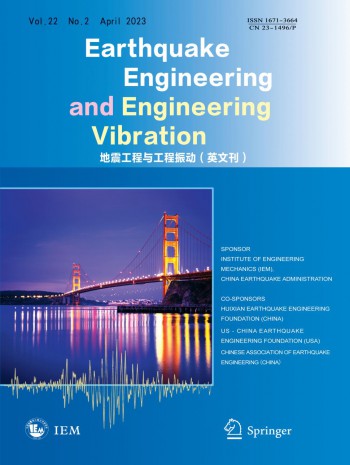
選定期刊
支付定金
確認完成服務
支付尾款
《Earthquake Engineering and Engineering Vibration》由中國地震局工程力學研究所主辦、美國多學科地震工程研究所中心(MCEER)協(xié)辦。
《Earthquake Engineering and Engineering Vibration》是反映我國地震工程與工程振動領域最新成果和國外該領域最新進展的學術性期刊,旨在促進國際學術交流,推動地震工程與工程振動學科的發(fā)展,減輕地震災害。
《Earthquake Engineering and Engineering Vibration》主要刊登以下內容的綜合評述、專題研究論文和科研簡報:結構和工程體系震害評定,強震觀測與分析,土木基礎設施的地震危害性與危險性分析,場地對結構的影響和巖土工程,建筑物與生命線系統(tǒng)的抗震性能和設計原理,結構控制,現(xiàn)有基礎設施系統(tǒng)的修復策略,結構動力學以及和地震工程相關的阻尼理論的進展,應急傳感與監(jiān)測系統(tǒng)和高性能材料在地震工程中的應用,以及風、波良和其它動荷載下土木工程結構振動問題。
CSCD 中國科學引文數(shù)據(jù)庫來源期刊(含擴展版)知網收錄(中)維普收錄(中)萬方收錄(中)EI 工程索引(美)SA 科學文摘(英)SCI 科學引文索引(美)劍橋科學文摘 中國優(yōu)秀期刊遴選數(shù)據(jù)庫中國期刊全文數(shù)據(jù)庫(CJFD)
強震觀測與分析 結構和工程體系震害評定 土木基礎設施的地震危害性和危險性分析 場地效應和巖土地震工程
Title Page:
The title page should contain: Title, Authors, Affiliations,
Acknowledgement, and Footnotes supplying: Correspondent
author‘s information including: the full name, complete mailing address, telephone and fax number, and, if available, e-mail address; Job titles of all authors; and The name(s) of sponsor(s) of the research contained in the paper, along with grant number(s), if any.
General: The manuscript should be provided in single-spaced typing Time New Roman, 10.5 pt., on A4 size pages in electronic format using Microsoft Word. It must be written in English and should not exceed 13,000 word-equivalents. (A journal page contains approximately 1,300 words.) Technical notes should not exceed 4,000 word-equivalents. If it is necessary to include additional information, such as appendices, these should be submitted electronically for inclusion on a web site for the journal.
Abstracts: Each paper should include an Abstract of 150-200 words, reporting concisely on the purpose of the work, the scope of the effort, the procedures used to execute the work (if of special interest), the major findings, and a list of three to eight keywords. The abstract must be self-contained, and it must not require reference to the paper to be understood.
Text: Follow this order when typing manuscripts: Title, Abstract, Keywords, Main text, Appendix, References, Vitage, Figures (including captions) and then Tables. Footnotes are to be avoided (except for table footnotes). Please complete text minus the title page, acknowledgment, and any running headers with author names, to allow blinded review.
Units: The SI system is to be used throughout; if it is necessary to use other units, these should be added in parentheses.
References
References should appear within the text as the author name(s) followed by the year of publication in parentheses. A list of all references must be given at the end of the text in alphabetical order by last name of first author. Make sure the reference information is complete and accurate, including as necessary and in the following order: last names and initials of all authors; year of publication; title of paper, report or book chapter (in quotes); title of book or periodical (in italic); volume and issue numbers; name and location of publisher (for books), name and location of publisher or sponsor for proceedings), or city of publication (for non-U.S. journals); and inclusive page numbers. The references should be listed in the following style:
Liu Huixian and Zhang Zaiyong (1980), “Lessons Learned from the 1976 Tangshan Earthquake,” Proceedings of the 7th World Conference on Earthquake Engineering, Vol. IX, Istanbul, Turkey, pp.453– 460.
Huo Linsheng and Li Hongnan (2004), “Torsionally Coupled Response Control of Offshore Platform Structures Using Circular Tuned Liquid Column Dampers,” China Ocean Engineering, 18(2):173–183. (in Chinese)
Newmark NM and Rosenblueth E (1971), Fundamentals of Earthquake Engineering, Prentice-Hall, Inc., Englewood Cliffs, N.J.
| 主題名稱 | 發(fā)文量 | 相關發(fā)文學者 |
| 地震 | 279 | |
| SEISMIC | 88 | |
| EARTHQUAKE | 80 | |
| AUTHORS | 56 | |
| 抗震 | 54 | |
| INSTRUCTIONS | 54 | |
| VIBRATION | 52 | |
| 混凝土 | 49 | |
| EARTHQUAKE_ENGINEERING | 43 | |
| EVENTS | 39 |
2012 2013 2014 2015 2016 2017 2018 2019 2020 2021
本刊文章發(fā)表的年份
在2012年的被引次數(shù)
被本刊自己引用的次數(shù)
被引次數(shù)的累積百分比
本刊文章發(fā)表的年份
在2013年的被引次數(shù)
被本刊自己引用的次數(shù)
被引次數(shù)的累積百分比
本刊文章發(fā)表的年份
在2014年的被引次數(shù)
被本刊自己引用的次數(shù)
被引次數(shù)的累積百分比
本刊文章發(fā)表的年份
在2015年的被引次數(shù)
被本刊自己引用的次數(shù)
被引次數(shù)的累積百分比
本刊文章發(fā)表的年份
在2016年的被引次數(shù)
被本刊自己引用的次數(shù)
被引次數(shù)的累積百分比
本刊文章發(fā)表的年份
在2017年的被引次數(shù)
被本刊自己引用的次數(shù)
被引次數(shù)的累積百分比
本刊文章發(fā)表的年份
在2018年的被引次數(shù)
被本刊自己引用的次數(shù)
被引次數(shù)的累積百分比
本刊文章發(fā)表的年份
在2019年的被引次數(shù)
被本刊自己引用的次數(shù)
被引次數(shù)的累積百分比
本刊文章發(fā)表的年份
在2020年的被引次數(shù)
被本刊自己引用的次數(shù)
被引次數(shù)的累積百分比
本刊文章發(fā)表的年份
在2021年的被引次數(shù)
被本刊自己引用的次數(shù)
被引次數(shù)的累積百分比
2012 2013 2014 2015 2016 2017 2018 2019 2020 2021
2012年本刊引用參考文獻出版年
對應的參考文獻數(shù)
累積百分比
2013年本刊引用參考文獻出版年
對應的參考文獻數(shù)
累積百分比
2014年本刊引用參考文獻出版年
對應的參考文獻數(shù)
累積百分比
2015年本刊引用參考文獻出版年
對應的參考文獻數(shù)
累積百分比
2016年本刊引用參考文獻出版年
對應的參考文獻數(shù)
累積百分比
2017年本刊引用參考文獻出版年
對應的參考文獻數(shù)
累積百分比
2018年本刊引用參考文獻出版年
對應的參考文獻數(shù)
累積百分比
2019年本刊引用參考文獻出版年
對應的參考文獻數(shù)
累積百分比
2020年本刊引用參考文獻出版年
對應的參考文獻數(shù)
累積百分比
2021年本刊引用參考文獻出版年
對應的參考文獻數(shù)
累積百分比
該期刊創(chuàng)刊于2002年,出版地方是黑龍江,先后獲得中國優(yōu)秀期刊遴選數(shù)據(jù)庫、中國期刊全文數(shù)據(jù)庫(CJFD)、等榮譽,是一本有一定影響力的學術期刊。
該期刊國際刊號:1671-3664,國內刊號:23-1496/P。相關信息可以在國家新聞出版總署網站上查詢。如果您還有疑問,可以聯(lián)系客服,了解更多詳情。
影響因子現(xiàn)已成為國際上通用的期刊評價指標,它不僅是一種測度期刊有用性和顯示度的指標,而且也是測度期刊的學術水平,乃至論文質量的重要指標。該期刊影響因子為0.21,復合影響因子為0.68。
根據(jù)出版周期的不同,期刊通常可分為月刊、雙月刊、季刊、半年刊、年刊、雙年刊等。該雜志的發(fā)行周期為季刊。發(fā)行周期會影響到文章的排期,如果您有需要,請盡早與我們聯(lián)系。
若用戶需要出版服務,請聯(lián)系出版商,地址:哈爾濱學府路9號,郵編:150080。